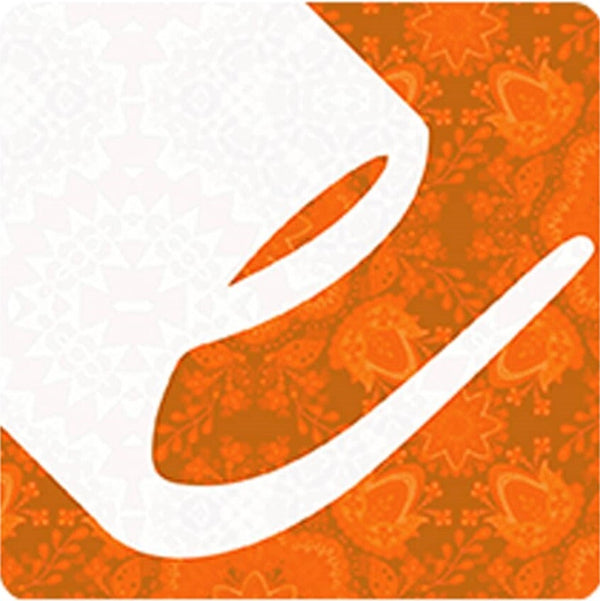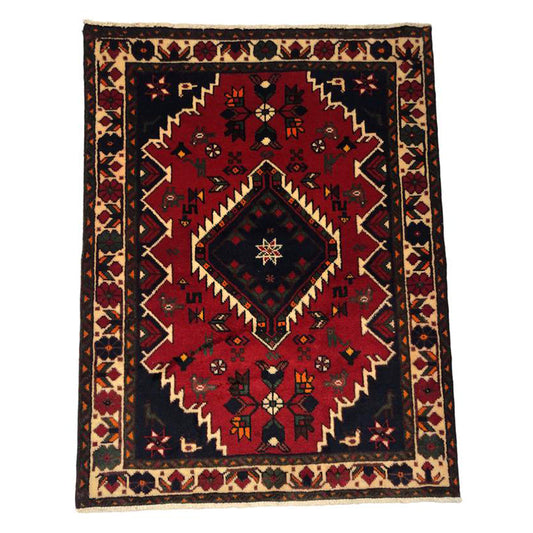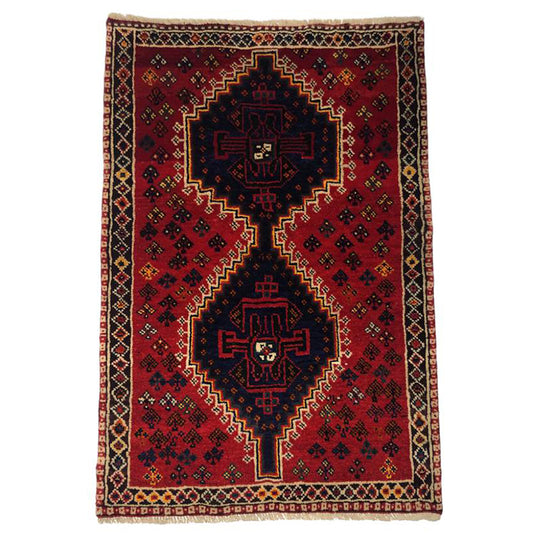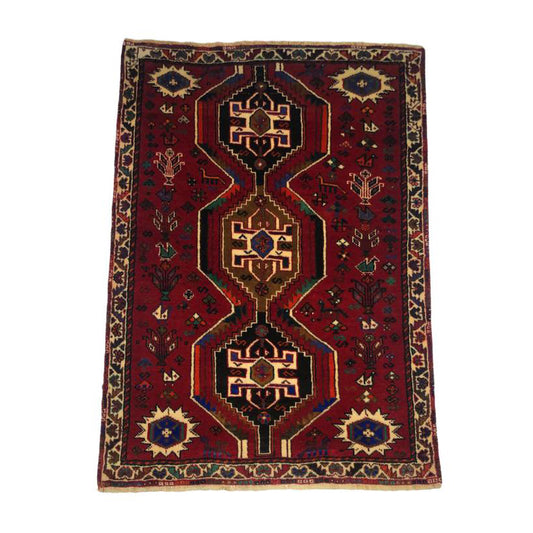Collection: Qashqai Rugs
The Qashqai people, a prominent confederation of tribes in Iran, are known for their rich cultural heritage and exquisite craftsmanship in rug weaving. Residing primarily in the Fars province, near historical sites like Shiraz and Persepolis, the Qashqai are the second largest Turkic group in Iran. Their nomadic lifestyle traditionally involves migrating with livestock between seasonal pastures, although many have settled into villages over time.
-
Qashqai Persian 145cm x 107cm
Regular price £100.00 GBPRegular priceUnit price / per£200.00 GBPSale price £100.00 GBPSale -
Qashqai Persian 151cm x 100cm
Regular price £375.00 GBPRegular priceUnit price / per£700.00 GBPSale price £375.00 GBPSale -
Qashqai Persian Red (168cm x 121cm)
Regular price From £300.00 GBPRegular priceUnit price / per£700.00 GBPSale price From £300.00 GBPSale -
Qashqai Persian Rug Burgundy (213cm x 132cm)
Regular price £600.00 GBPRegular priceUnit price / per£1,200.00 GBPSale price £600.00 GBPSale -
Qashqai Persian Rug Red (172cm x117cm)
Regular price £280.00 GBPRegular priceUnit price / per£600.00 GBPSale price £280.00 GBPSale
Qashqai Rug: Dye Technique, Pattern Meaning, Loom Construction, Knotting Technique
The Tribe
The name "Qashqai" is believed to derive from a Turkic word meaning "horse with a white blaze," symbolizing good fortune. This tribe consists of various clans, each contributing unique styles to their rug-making tradition. The Qashqai weavers are predominantly women who learn the art of weaving from a young age, often creating rugs from memory, reflecting their deep connection to their heritage.
How Qashqai Rug is made?
Qashqai rugs are handwoven primarily by women, using a horizontal loom pegged to the ground. The pile, warp, and weft are all made of wool, and the distinctive red weft thread adds a unique character to each piece. The weave is fine and dense, making Qashqai rugs heavier and more durable than similar styles like the Shiraz rugs.
Qashqai rugs are also made as flat-woven Kilims, featuring no pile, where the weft threads create both the pattern and the vibrant colors. Whether you’re drawn to the plush wool or the sleek flat weave of a Kilim, each Qashqai rug tells the story of a tribe, its journey, and its legacy.
How to Identify a Qashqai Rug?
To accurately identify a Qashqai rug, follow these key steps, focusing on specific characteristics with proven facts.
Material: Feel the material. It should be soft yet firm. The wool may feel slightly oily due to natural lanolin.
Knot Density: Look for a knot density between 80 to 200 KPSI (knots per square inch). Count the knots on the back of the rug for an accurate measure.
Irregular Design: Examine the layout of the design. If it's irregular, it could indicate hand-weaving. A perfect, machine-like design suggests it's not a Qashqai rug.
Color: Rub a damp cloth on the rug to check for colorfastness. Natural dyes will not bleed easily, while synthetic dyes may.
Fringe: Check if the fringe is an integral part of the rug. Tug lightly on the fringe to see if it pulls away easily. If it does, it’s not an authentic Qashqai rug.
Knot Visibility: On the back, the knots should be clearly visible, showing the detailed handwork. Flip the rug and inspect the backside for uniform knots. Machine-made rugs have an overly uniform appearance.
Texture: Press your hand firmly on the rug. It should feel dense and resilient, not flat or too soft.
Dyeing Techniques
The Qashqai are known for their mastery of natural dyeing, a skill passed down through generations. The vibrant colors in Qashqai rugs are often derived from natural sources like plants, roots, and insects. For example:
- Madder root produces a range of reds, from deep crimson to lighter hues.
- Indigo is used for deep blues.
- Walnut husks contribute to rich brown and gold tones.
Qashqai Rug Pattern Meaning
The geometric patterns and motifs found in Qashqai rugs carry deep symbolic meanings that reflect the nomadic lifestyle and beliefs of the tribe. For example:
The diamond-shaped medallion in the center often symbolizes protection and strength.
Stylized birds represent freedom, hope, and travel.
Animal motifs, especially goats and camels, signify prosperity and the essential role of livestock in the Qashqai's nomadic way of life.
Flowers and leaves symbolize the fertility of the land and the tribe’s close connection to nature.
Nomadic Loom Construction
Qashqai rugs are created on portable looms, which are simple, horizontal structures that can be assembled and disassembled easily as the tribe moves. This type of loom impacts the size and shape of the rug, often resulting in variations that make each rug unique. The weaver adjusts the tension of the wool as needed, adding to the distinctive character of the rug.
Knotting Technique
Qashqai rugs use the asymmetrical Persian knot (Senneh knot), which allows for more detailed and intricate patterns. The knotting is done by hand, and a typical Qashqai rug has a knot density ranging from 120 to 300 knots per square inch, depending on the region and the weaver’s style. This fine knotting contributes to the durability and sharpness of the designs.
Color Variations and Abrash
One of the most prized features in Qashqai rugs is the presence of abrash, a natural variation in color that occurs due to differences in dye batches or the absorption of dye by wool. This creates subtle shifts in color tones, often noticeable in larger fields of solid color, which gives the rug a dynamic, “alive” quality. Abrash is highly valued by collectors and is considered a mark of authenticity in hand-woven rugs.
Cultural Legacy and Preservation
Qashqai rugs not only serve as floor coverings but are also regarded as cultural heirlooms. Each rug tells a personal story about the weaver's life, with many women incorporating patterns that symbolize key events such as births, marriages, and seasons of migration.
High Altitude Influence
The Qashqai people often wove their rugs while living at higher altitudes during their seasonal migrations. This affects the quality of the wool used in the rugs, as sheep grazing at higher altitudes tend to produce thicker, more durable wool.
Regional Variations
While Qashqai rugs are often lumped together, there are subtle regional variations within the Qashqai confederation. Rugs from different subtribes or regions may have distinctive color palettes, patterns, or weave structures. For instance:
Darreshuri rugs are known for their fine weaving and dark, bold colors.
Amaleh rugs often feature softer color tones and slightly more open patterns. This regional diversity within the Qashqai confederation adds to the rich variety found among Qashqai rugs.
Frequently asked questions
What is the Fringe Length of a Qashqai Rug?
The Fringe Length of the Qashqai rug is 1-2 inches.
How can I tell if a Qashqai rug is antique or new?
New rugs are typically less than 20 years old, semi-antique between 20-50 years, and antique rugs are 50+ years old.
What kind of dyes are used in Qashqai Rug, and how long do the colors last?
Qashqai rugs use natural vegetable dyes which are known to last for 50+ years with minimal fading due to their organic nature.
Why do Qashqai rugs have intricate patterns?
Qashqai rugs have 3-7 recurring geometric motifs, like diamonds and medallions, which symbolize protection, nature, or life.
Are Qashqai rugs symmetrical?
No, they often feature asymmetrical designs due to the tribal, nomadic weaving style, giving each rug a unique, handcrafted look.
What are the differences between Gabbeh, Lori, and Shiraz rugs?
Gabbeh rugs have simple patterns, Lori rugs are more intricate with tribal designs, and Shiraz is a modern variation.
Are Qashqai rugs prone to moth damage?
Wool used in Qashqai rugs is naturally moth-resistant due to lanolin, but regular cleaning and care are recommended.
Will the colors of a Qashqai rug fade if exposed to sunlight?
Qashqai rugs have high UV resistance, with minimal fading even after years of exposure to sunlight, due to natural dyes.
Do Qashqai rugs have a special type of edge binding?
Yes, they have hand-sewn selvage (edge binding) which prevents unraveling and increases the rug’s lifespan.
Are Qashqai rugs suitable for humid environments?
Yes, wool can absorb up to 30% of its weight in moisture without feeling damp, making it ideal for humid conditions.
How thick are Qashqai rugs?
Qashqai Rugs are typically 10-15 mm thick, depending on the knot density and wool pile, offering both comfort and durability.
Are Qashqai rugs good for people with allergies?
Yes, wool fibers trap dust but don’t release allergens into the air, making them relatively hypoallergenic compared to carpets.
Are Qashqai rugs durable enough for high-traffic areas?
Yes, with high abrasion resistance due to their dense wool pile and strong knots, making them ideal for high-traffic areas.
Are Qashqai rugs suitable for colder climates?
Yes, Qashqai rugs provide natural insulation, with wool capable of retaining warmth, making them ideal for cold climates.
How resistant are Qashqai rugs to tearing?
With a tear strength of 45-50 N, Qashqai rugs are resistant to tearing and pulling, making them durable even in busy households.
Why are no two Qashqai rugs exactly alike?
Each rug is handmade, with artisan variation, allowing weavers to express personal creativity, making every rug one-of-a-kind.
How heavy are Qashqai rugs compared to other hand-knotted rugs?
Qashqai rugs weigh 4-6 kg per square meter, heavier than machine-made rugs due to the dense hand-knotted construction.
How strong are Qashqai rugs?
The wool in Qashqai rugs has a tensile strength of 500-600 N/cm², making them strong and resistant to daily wear and tear.
How long does it take to make a Qashqai rug by hand?
A medium-sized (6' x 9') rug typically takes 6-12 months to weave, depending on the knot count and pattern complexity.
Are Qashqai rugs made with wool or cotton foundations?
They are made with cotton or wool foundations, with newer rugs typically using cotton for stability, while older rugs use wool.
Do Qashqai rugs have a shiny finish?
Qashqai rugs have a medium to low luster, depending on wool quality and the weaving technique, which gives a rich, warm look.
What type of wool is used in Qashqai rugs?
Hand-spun wool from highland sheep is used, providing a soft yet durable texture. The wool contains natural lanolin for strength.
Are Qashqai rugs known for their vibrant colors?
Yes, they are known for their vibrant reds, blues, and browns, with color fastness lasting for decades due to natural dyes.





